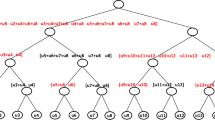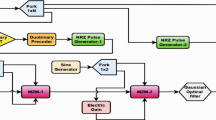Abstract
This paper proposes a two-dimensional (2-D) digital predistortion (DPD) technique using vector quantization piecewise (VQP) method to compensate for nonlinearities of power amplifiers (PAs) in concurrent dual-band wireless transmitters. 2-D DPD architecture is used to extract the predistortion coefficients and linearize the PA in each band separately, which results in lower sampling rates of digital-to-analog and analog-to-digital converters compared to traditional 1-D method. Vector quantization method is introduced to divide the 2-D signal space into several regions in terms of signal amplitude probability distribution and subtle 2-D memory polynomial (MP) models are assigned to the regions, thus the proposed technique can linearize the PA in the whole signal amplitude range successfully due to the fact that PA nonlinearities are usually dependent on amplitude modulation characteristics strongly. The performance of dual-band wideband code division multiple access (WCDMA) signals which are 100 MHz apart is investigated. The simulation results show that when the region number is 16, 2-D VQP DPD implement can improve the PA’s adjacent channel power ratio (ACPR) by about 13dBc, and it is 8 dB better than the 2-D PDD method.






Similar content being viewed by others
References
Kim, B., Kim, I., & Moon, J. (2010). Advanced Doherty architecture. IEEE Microwave Magazine, 11(5), 72–86.
Jia, S., Chen, W., & Schreurs, D. (2015). A novel doherty transmitter based on antenna active load modulation. IEEE Microwave and Wireless Components Letters, 25(4), 271–273.
Wang, F., Yang, A. H., Kimball, D. F., Larson, L. E., & Asbeck, P. M. (2005). Design of wide-bandwidth envelope-tracking power amplifiers for OFDM applications. IEEE Transactions on Microwave Theory and Techniques, 53(4), 1244–1255.
Park, S., Woo, J. L., Kim, U., & Kwon, Y. (2015). Broadband CMOS stacked RF power amplifier using reconfigurable interstage network for wideband envelope tracking. IEEE Transactions on Microwave Theory and Techniques, 63(4), 1174–1185.
Ding, L., Zhou, G. T., & Morgan, D. R. (2004). A robust digital baseband predistorter constructed using memory polynomials. IEEE Transactions on Communications, 52(1), 159–165.
Guan, L., & Zhu, A. (2014). Green communications: Digital predistortion for wideband RF power amplifiers. IEEE Microwave Magazine, 15(4), 84–99.
Swaminathan, J. N., & Kumar, P. (2015). Design of efficient adaptive predistorter for nonlinear high power amplifier. Wireless Personal Communications, 82(2), 1085–1093.
Roblin, P., Myoung, S. K., Chaillot, D., Kim, Y. G., Fathimulla, A., Strahler, J., et al. (2008). Frequency-selective predistortion linearization of RF power amplifiers. IEEE Transactions on Microwave Theory and Techniques, 56(1), 65–76.
Bassam, S. A., Helaoui, M., & Ghannouchi, F. M. (2011). 2-D digital predistortion (2-D-DPD) architecture for concurrent dual-band transmitters. IEEE Transactions on Microwave Theory and Techniques, 59(10), 2547–2554.
Ding, L., Yang, Z., & Gandhi, H. (2012). Concurrent dual-band digital pre-distortion. In IEEE MTT-S International Microwave Symposium Digest (pp. 1–3).
Liu, Y. J., Chen, W. H., Zhou, J., Zhou, B. H., & Ghannouchi, F. M. (2013). Digital predistortion for concurrent dual-band transmitters using 2-D modified memory polynomials. IEEE Transactions on Microwave Theory and Techniques, 61(1), 281–290.
Fehri, B., & Boumaiza, S. (2004). Baseband equivalent Volterra series for digital predistortion of dual-band power amplifiers. IEEE Transactions on Microwave Theory and Techniques, 62(3), 700–714.
Younes, M., & Ghannouchi, F. M. (2015). Behavioral modeling of concurrent dual-band transmitters based on radially-pruned Volterra model. IEEE Communications Letters, 19(5), 751–754.
Moon, J., Saad, P., Son, J., Fager, C., & Kim, B. (2012). 2-D enhanced hammerstein behavior model for concurrent dual-band power amplifiers. In 42nd European Microwave Conference (pp. 1249–1252).
Quindroit, C., Naraharisetti, N., Roblin, P., Gheitanchi, S., Mauer, V., & Fitton, M. (2013). 2D forward twin nonlinear two-box model for concurrent dual-band digital predistortion. In IEEE Topical Conference on Power Amplifier Wireless and Radio Applications (pp. 25–27).
Zhu, A., Draxler, P. J., Hsia, C., Brazil, T. J., Kimball, D. F., & Asbeck, P. M. (2008). Digital predistortion for envelope-tracking power amplifiers using decomposed piecewise volterra series. IEEE Transactions on Microwave Theory and Techniques, 56(10), 2237–2247.
Naraharisetti, N., Roblin, P., Quindroit, C., & Gheitanchi, S. (2015). Efficient least-squares 2-D-cubic spline for concurrent dual-band systems. IEEE Transactions on Microwave Theory and Techniques, 63(7), 2199–2210.
Afsardoost, S., Eriksson, T., & Fager, C. (2012). Digital predistortion using a vector-switched model. IEEE Transactions on Microwave Theory and Techniques, 60(4), 1164–1174.
Gersho, A., & Gray, R. M. (2005). Vector quantization and signal compression. Berlin: Springer.
Morgan, D., Ma, Z., Kim, J., Zierdt, M., & Pastalan, J. (2006). A generalized memory polynomial model for digital predistortion of RF power amplifiers. IEEE Transactions on Signal Processing, 54(10), 3852–3860.
Linde, Y., Buzo, A., & Gray, R. (1980). An algorithm for vector quantizer design. IEEE Transactions on Communications, 28(1), 84–85.
Draxler, P., Yan, J., Kimball, D., & Asbeck, P. (2012). Digital predistortion for envelope tracking power amplifiers. In Proceedinds on 13th Wireless Wireless and Microwave Technology Conference (pp. 1–7).
Acknowledgments
This work was partly supported by the Natural Science Foundation of China under Grant No. 61401380.
Author information
Authors and Affiliations
Corresponding author
Rights and permissions
About this article
Cite this article
Xiong, M., Wu, X., Guan, E. et al. 2-D Digital Predistortion Using Vector Quantization Method for Dual-Band Transmitters. Wireless Pers Commun 94, 643–657 (2017). https://doi.org/10.1007/s11277-016-3641-x
Published:
Issue Date:
DOI: https://doi.org/10.1007/s11277-016-3641-x




